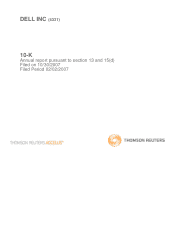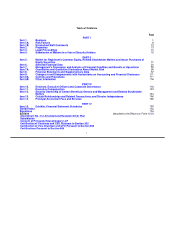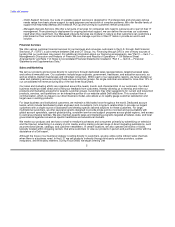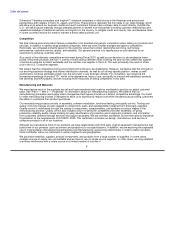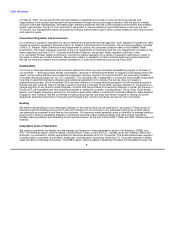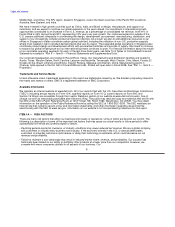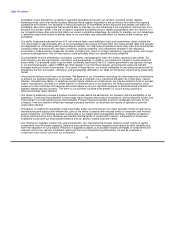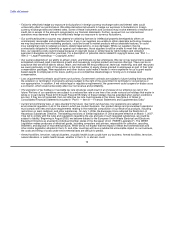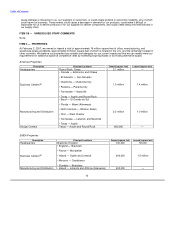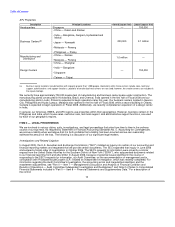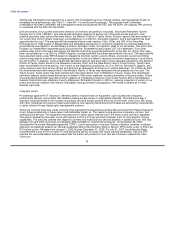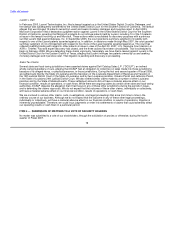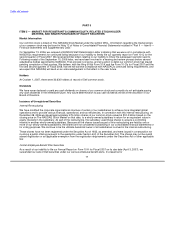Dell 2006 Annual Report Download - page 10
Download and view the complete annual report
Please find page 10 of the 2006 Dell annual report below. You can navigate through the pages in the report by either clicking on the pages listed below, or by using the keyword search tool below to find specific information within the annual report.
Table of Contents
we believe it is advantageous due to performance, quality, support, delivery, capacity, or price considerations. This
relationship and dependency has not caused material disruptions in the past, and we believe that any disruptions that may
occur because of our dependency on single- or limited-source suppliers would not disproportionately disadvantage us
relative to our competitors. See "Part I — Item 1A — Risk Factors" for information about the risks associated with single- or
limited-sourced suppliers.
Patents, Trademarks, and Licenses
As of October 12, 2007, we held a worldwide portfolio of 1,890 patents and had an additional 2,001 patent applications
pending. We also hold licenses to use numerous third party patents. To replace expiring patents, we obtain new patents
through our ongoing research and development activities. The inventions claimed in our patents and patent applications
cover aspects of our current and possible future computer system products, manufacturing processes, and related
technologies. Our product, business method, and manufacturing process patents may establish barriers to entry in many
product lines. While we use our patented inventions and also license them to others, we are not substantially dependent on
any single patent or group of related patents. We have entered into a variety of intellectual property licensing and cross-
licensing agreements. We have also entered into various software licensing agreements with other companies. We anticipate
that our worldwide patent portfolio will be of value in negotiating intellectual property rights with others in the industry.
We have obtained U.S. federal trademark registration for the DELL word mark and the Dell logo mark. We own registrations
for 56 of our other marks in the U.S. At October 12, 2007, we had pending applications for registration of 31 other
trademarks. We believe that establishment of the DELL word mark and logo mark in the U.S. is material to our operations.
We have also applied for or obtained registration of the DELL mark and several other marks in approximately 195 other
countries.
We have entered into a variety of intellectual property licensing and cross-licensing agreements. We have also entered into
various software licensing agreements with a variety of other companies.
From time to time, other companies and individuals assert exclusive patent, copyright, trademark, or other intellectual
property rights to technologies or marks that are important to the technology industry or our business. We evaluate each
claim relating to our products and, if appropriate, seek a license to use the protected technology. The licensing agreements
generally do not require the licensor to assist us in duplicating its patented technology, nor do these agreements protect us
from trade secret, copyright, or other violations by us or our suppliers in developing or selling these products.
Employees
At the end of Fiscal 2007, we had approximately 90,500 total employees (consisting of 82,200 regular employees, 7,200
temporary employees, and 1,100 DFS employees), compared to approximately 73,500 total employees (consisting of 65,200
regular employees, 7,200 temporary employees, and 1,100 DFS employees) at the end of Fiscal 2006. Approximately
29,100 of the regular employees at the end of Fiscal 2007 were located in the U.S., and approximately 53,100 were located
in other countries. While our workforce located both inside and outside the U.S. continued to increase during Fiscal 2007, the
proportion of our workforce located outside the U.S. increased due to a number of factors, including our rapid international
growth. We have never experienced a work stoppage due to labor difficulties, and believe that our employee relations are
good.
Workforce diversity is an essential part of our commitment to quality and the future of our company. In Fiscal 2006, we
received the 2005 Secretary of Labor Opportunity Award, which is the highest award given by the Department of Labor to
federal contractors for their voluntary diversity efforts. In addition, we rank number two on DiversityBusiness.com's list of
"Top Organizations for Multicultural Business Opportunities of 2006," which represents the top 50 Fortune 500 companies
that best promote multicultural business opportunities. We have also been recognized as one of the best places to work by
the Human Rights Campaign.
7

